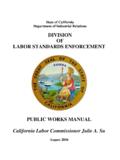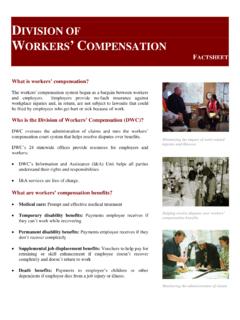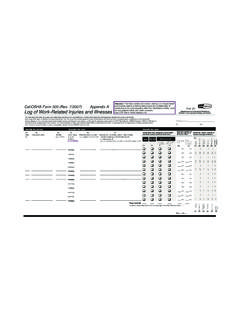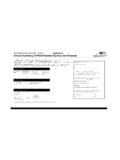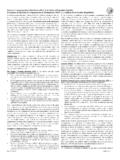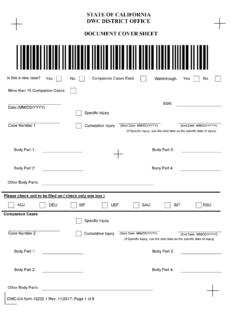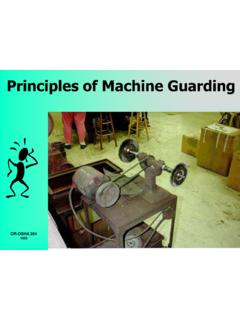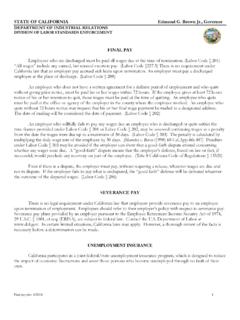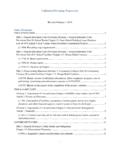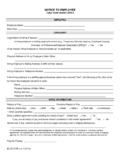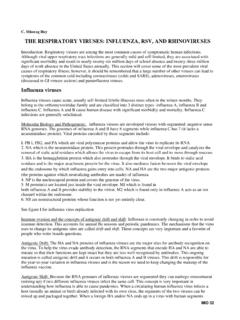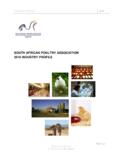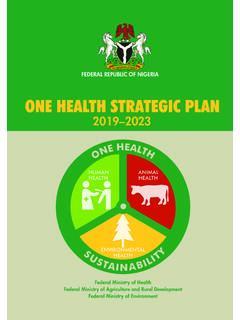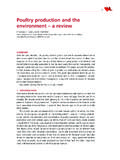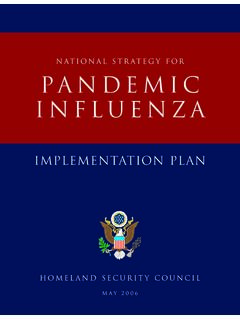Transcription of THE CALIFORNIA ORKPLACE UIDE TO AEROSOL
1 THE CALIFORNIA WORKPLACE GUIDE TOAEROSOLTRANSMISSIBLEDISEASESD epartment of Industrial RelationsDivision of Occupational Safety and HealthPublications UnitApril 2020 The CALIFORNIA Workplace Guide to AEROSOL transmissible DiseasesContentsAbbreviations and Acronyms Used in This Publication ..iAbout This Publication ..iiIntroduction1 Referring Employers7 Written Programs and Procedures 14 Engineering and Work Practice Controls and Personal Protective Equipment16 Laboratories24 Respiratory Protection29 Medical Services35 Training41 Recordkeeping43 Quick Summary Guides46 Resources52 Cover images:A man sneezing with droplets visibleCredit: Centers for disease Control and Prevention/Brian JuddA transmission electron microscopic (TEM) image of a grouping of H1N1 influenza particlesCredit: National Institute of Allergy and Infectious Diseases (NIAID)A 3D computer-generated image of Corynebacterium diphtheriae bacteria based on scanning electron microscopic imageryCredit: CDC/Sarah Bailey CutchinA 3D computer-generated image of a group of Steptococcus pneumoniae bacteria based on scanning electron microscopic imageryCredit.
2 CDC/Sarah Bailey Cutchin AEROSOL transmissible DiseasesiAbbreviations and Acronyms Used in This PublicationACH Air changes per hourAII Airborne infection isolationAIIR Airborne infection isolation room or areaAirID Airborne infectious diseaseAirIP - Airborne infectious pathogenATD AEROSOL transmissible diseaseATP AEROSOL transmissible pathogenATP-L - AEROSOL transmissible pathogen - laboratoryBMBL Biosafety in Microbiological and Biomedical LaboratoriesBSL Biosafety levelBSP Biosafety planCCR CALIFORNIA Code of RegulationsCDPH CALIFORNIA Department of Public HealthCDC Centers for disease Control and PreventionECP Exposure Control PlanHEPA High-efficiency particulate air (filtration)LHD Local health departmentLHO Local health officerPAPR Powered air-purifying respiratorPLHCP Physician or other licensed health care professionalRATD Reportable AEROSOL transmissible diseaseSARS Severe acute respiratory syndromeSCBA Self-contained breathing apparatusTB - Tuberculosis AEROSOL transmissible DiseasesiiAbout This PublicationCalifornia workplace safety laws require certain employers with employees exposed to AEROSOL transmissible diseases (ATD) to have effective written safety plans, provide protective equipment as needed, and train employees on safety procedures.
3 This publication is designed to assist employers with meeting the requirements of the Cal/OSHA AEROSOL transmissible Diseases standard ( CALIFORNIA Code of Regulations, title 8, section 5199) to reduce the risk of ATD infection to their of ATDs include tuberculosis (TB), influenza , and pertussis (whooping cough).The following topics are covered: The introduction explains the categories of AEROSOL transmissible diseases covered under this standard, the types of employers who must comply, and the types of employers who are conditionally exempt . The Referring Employers section describes the conditions that employers must meet in order to be classified as a referring employer and specifies the requirements they must comply with instead of the entire ATD regulation . The Written Programs and Procedures section is a brief description of the written programs required of the different types of employers, including the requirements of an ATD Exposure Control Plan.
4 The Engineering and Work Practice Controls section discusses different kinds of engineering and work practice controls that are required to protect employees against infection, including airborne infection isolation rooms or areas, and the maintenance requirements of such controls. The Laboratories section discusses the requirements for laboratories where employees conduct procedures with materials that contain or may contain AEROSOL transmissible pathogens-laboratory, including the requirements of a Biosafety Plan . The Respiratory Protection section describes different kinds of respirators and considerations when selecting respirators for protection against ATD exposures. This section also summarizes a few requirements of the Cal/OSHA Respiratory Protection standard . The Medical Services section explains the requirements for different medical services the employer must provide, including vaccinations, annual TB screening, and post-exposure evaluation and follow-up.
5 The Training section describes the requirements for training employees who have occupational exposure to ATDs . The Recordkeeping section outlines the recordkeeping requirements of the ATD standard . The Quick Summary Sheets list the ATD regulation requirements for six types of employers so they may quickly and easily see everything they need to do to comply . The Resources section lists all the resources referenced in this publication . This document is not meant to be either a substitute for or a legal interpretation of the occupational safety and health regulations. Readers must refer directly to title 8 of the CALIFORNIA Code of Regulations for details, exceptions, and other requirements that may apply to their operations. Please refer to the full regulation at text boxes throughout this document contain the URLs of hyperlinks introduced on that page.
6 Blue text boxes throughout this document contain notes .1 AEROSOL transmissible Diseases8 CCR 5199: CCR 5199, Appendix A: CCR 5199, Appendix D: Cal/OSHA AEROSOL transmissible Diseases (ATD) standard was adopted in 2009 to protect employees who are at increased risk of contracting certain airborne infections due to their work activities. The standard is codified in title 8 of the CALIFORNIA Code of Regulations, section 5199 .What is an AEROSOL transmissible disease under this regulation?Section 5199 defines an AEROSOL transmissible disease as a disease for which droplet or airborne precautions are required, as listed in Appendix A, which has been reproduced on the next page. These diseases can be transmitted by infectious particles or droplets through inhalation or direct contact with the mucous membranes of the eyes or respiratory tract . The disease -causing aerosols covered by this regulation are pathogens, such as bacteria and ATD standard identifies three categories of AEROSOL transmissible diseases/pathogens: Airborne infectious diseases (AirID)/airborne infectious pathogens (AirIP) are diseases, such as tuberculosis (TB), that are transmitted through the air.
7 They are listed in Appendix A as requiring airborne infection isolation (AII). Airborne precautions include the use of special engineering controls and respiratory protection . AirID/AirIP include novel and unknown pathogens . Section 5199 also requires employers to follow AII requirements for any disease or pathogen for which the CALIFORNIA Department of Public Health (CDPH) or local health officer (LHO) recommends AII. ATDs/ AEROSOL transmissible pathogens (ATPs) requiring droplet precautions are diseases, such as mumps and pertussis, that transmit by infectious particles or droplets coming into contact with the eyes, upper respiratory tract, or mucous membranes of the nose or mouth. Droplet precautions include protecting the eyes and mucous membranes from contact with shorter range droplets . Section 5199 also requires employers to use droplet precautions for a disease or pathogen if the CDPH or LHO recommends them.
8 AEROSOL transmissible pathogens laboratory (ATP-L) are pathogens that may be spread through laboratory-generated aerosols and include pathogens listed in Appendix D, pathogens for which Biosafety in Microbiological and Biomedical Laboratories (BMBL) recommends biosafety level 3 (BSL 3) or above, pathogens for which the biosafety officer recommends BSL 3 or above, and novel or unknown pathogens .Note: Some diseases or pathogens, such as SARS and SARS coronavirus, appear on more than one list. For exposures to such pathogens, both airborne and droplet precautions must be used. IntroductionPhoto credit: CDC/Brian Judd IntroductionAerosol transmissible DiseasesWhat is an AEROSOL transmissible disease under this regulation?2 Section 5199, Appendix A AEROSOL transmissible Diseases/Pathogens (Mandatory)This appendix contains a list of diseases and pathogens which are to be considered AEROSOL transmissible pathogens or diseases for the purpose of Section 5199.
9 Employers are required to provide the protections required by Section 5199 according to whether the disease or pathogen requires airborne infection isolation or droplet precautions as indicated by the two lists below .Diseases/Pathogens Requiring Airborne Infection Isolation Aerosolizable spore-containing powder or other substance that is capable of causing serious human disease , Anthrax/Bacillus anthracis avian influenza / avian influenza A viruses (strains capable of causing serious disease in humans) Varicella disease (chickenpox, shingles)/Varicella zoster and Herpes zoster viruses, disseminated disease in any patient. Localized disease in immunocompromised patient until disseminated infection ruled out Measles (rubeola)/Measles virus Monkeypox/Monkeypox virus Novel or unknown pathogens Severe acute respiratory syndrome (SARS) Smallpox (variola)/Varioloa virus Tuberculosis (TB)/Mycobacterium tuberculosis -- Extrapulmonary, draining lesion; Pulmonary or laryngeal disease , confirmed.
10 Pulmonary or laryngeal disease , suspected Any other disease for which public health guidelines recommend airborne infection isolationDiseases/Pathogens Requiring Droplet Precautions Diphtheria pharyngeal Epiglottitis, due to Haemophilus influenzae type b Haemophilus influenzae Serotype b (Hib) disease /Haemophilus influenzae serotype b -- Infants and children influenza , human (typical seasonal variations)/ influenza viruses Meningitis Haemophilus influenzae, type b known or suspected Neisseria meningitidis (meningococcal) known or suspected Meningococcal disease sepsis, pneumonia (see also meningitis) Mumps (infectious parotitis)/Mumps virus Mycoplasmal pneumonia Parvovirus B19 infection (erythema infectiosum) Pertussis (whooping cough) Pharyngitis in infants and young children/Adenovirus, Orthomyxoviridae, Epstein-Barr virus, Herpes simplex virus, Pneumonia Adenovirus Haemophilus influenzae Serotype b, infants and children Meningococcal Mycoplasma, primary atypical Streptococcus Group A Pneumonic plague/Yersinia pestis Rubella virus infection (German measles)/Rubella virus Severe acute respiratory syndrome (SARS) Streptococcal disease (group A streptococcus) Skin, wound or burn, Major Pharyngitis in infants and young children Pneumonia Scarlet fever in infants and young children Serious invasive disease Viral hemorrhagic fevers due to Lassa, Ebola, Marburg, Crimean-Congo fever viruses (airborne infection isolation and respirator use may be required for AEROSOL -generating procedures)
